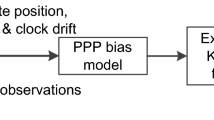Abstract
GPS precise point positioning (PPP) is increasingly being used in many precise positioning applications to achieve sub-meter level accuracy using a stand-alone user receiver. To achieve the full-scale navigation parameters of position, velocity and attitude, GPS is often combined with the inertial navigation system (INS) to deliver navigation solutions in high update rate. However, GPS signals cannot always be tracked in difficult areas, which leads to an integration performance degradation because of INS sensor errors. Therefore, the authors propose a PPP-GPS/INS/odometer/map-matching integrated navigation system. The positioning performance based on the different International GNSS Service (IGS) products for train kinematic positioning applications is investigated. A field test was conducted on a specific low-density line to evaluate the proposed system. The test results confirm that the proposed multi-sensor navigation system can provide seamless navigation in both GPS available and unavailable situations with the accuracy of decimeter. Different IGS satellite orbits and clock offset products were used to generate the PPP results, and it was concluded that the IGS final products provide the best performance, with a distance root mean square (DRMS) of 0.138 m, and the IGS ultra-rapid product can also generate acceptable positioning solutions with a DRMS of 0.222 m.












Similar content being viewed by others
References
Acharya A, Smita S, Ghoshal T (2011) Train localization and parting detection using data fusion. Transp Res Part C 19(1):75–84
Allotta B, Pugi L, Ridolfi A, Malvezzi M, Vettori G, Rindi A (2012) Evaluation of odometry algorithm performances using a railway vehicle dynamic model. Veh Syst Dyn 50(5):699–724
Boehm J, Niell A, Tregoning P, Schuh H (2006) Global Mapping Function (GMF): a new empirical mapping function based on numerical weather model data. Geophys Res Lett 33(7):L07304
Dow J, Neilan R, Rizos C (2015) The international GNSS service in a changing landscape of global navigation satellite systems. J Geodesy 83(3–4):191–198
Gao Z, Ge M, Shen W, Li Y, Chen Q, Zhang H, Niu X (2017) Evaluation on the impact of IMU grades on BDS + GPS PPP/INS tightly coupled integration. Adv Space Res 60(6):1283–1299
Gerlach K, Rahmig C (2009) Multi-hypothesis based map-matching algorithm for precise train positioning. In: 12th international conference on information fusion, Seattle, Washington, USA, July 6–9, pp 1363–1369
Guo J, Xu X, Zhao Q, Liu J (2016) Precise orbit determination for quad-constellation satellites at Wuhan University:strategy, result validation, and comparison. J Geodesy 90(2):143–159
Gurnik P (2016) Next generation train control (NGTC): more effective railways through the convergence of main-line and urban train control systems. Transp Res Procedia 14:1855–1864
Heirich O (2016) Bayesian train localization with particle filter, loosely coupled GNSS, IMU, and a track map. J Sensors 2016:1–15
Hemerly E, Schad V (2008) Implementation of a GPS/INS/odometer navigation system. In: ABCM symposium series in mechatronics, vol 3, pp 519–524
IERS:IERS conventions (2010) Petit G, Luzum B (eds) (IERS Technical Note 36) Frankfurt am Main: Verlag des Bundesamtes für Kartographie und Geodäsie. ISBN 3-89888-989-6, 179
IGS (2017) IGS quality of service fact sheet. http://kb.igs.org/hc/enus/article_attachments/200407513/IGS_Quality_of_Service_131121.pdf
Jaradat MA, Abdel-Hafez MF (2014) Enhanced, delay dependent, intelligent fusion for INS/GPS navigation system. IEEE Sens J 14(5):1545–1554
Jiang W, Li Y, Rizos C (2015) Locata-based precise point positioning for kinematic maritime applications. GPS Solut 19(1):117–128
Jonas M (2015) Integrity of GNSS position solution for safety related applications. In: Proceedings of ION ITM 2015, Institute of Navigation, Tampa, Florida, USA, September 14-18, pp 1603–1607
Kouba J (2009) A guide to using International GNSS Service (IGS) products [online]. IGS Central Bureau, May. http://igscb.jpl.nasa.gov/igscb/resource/pubs/UsingIGSProductsVer21.pdf
Li Y (2014) Optimal multisensor integrated navigation through information space approach. Phys Commun SI Indoor Navig Track 13(A):44–53
Li Z, Zheng N, Wang J, Gao J (2018) Performance comparison among different precise satellite ephemeris and clock products for PPP/INS/UWB tightly coupled positioning. J Navig 71(3):585–606
Montenbruck O et al (2017) The multi-GNSS experiment (MGEX) of the international GNSS service (IGS)—achievements, prospects and challenges. Adv Space Res 59(7):1671–1697
Mowafy A, Deo M, Kubo N (2016) Maintaining real-time precise point positioning during outages of orbit and clock corrections. GPS Solut 21(3):937–947
Quddus M, Washington S (2015) Shortest path and vehicle trajectory aided map-matching for low frequency GPS data. Transp Res Part C Emerg Technol 55:328–339
Saab S (2000) A map matching approach for train positioning part I, development and analysis. IEEE Trans Veh Technol 49(2):467–475
Saastamoinen J (1973) Contribution to the theory of atmospheric refraction. Bulletin Geodesique 107:13–34
Shi J (2012) Precise point positioning integer ambiguity resolution with decoupled clocks. Ph.D thesis. University of Calgary, Calgary, Alberta, Canada
Simsky A, Wilms F, Franckart JP (2004) GNSS-based failsafe train positioning system for low-density traffic lines based on one dimensional positioning algorithm. In: 2nd ESA workshop on satellite navigation user equipment technologies NAVITEC 2004, Noordwijk, The Netherlands, December 8-10, CD proc
Springer T, Hugentobler U (2016) IGS ultra rapid products for (near-) real-time applications. Phys Chem Earth Part A Solid Earth Geodesy 26(6–8):623–628
Wichayangkoon B (2000) Elements of GPS precise point positioning. Dissertation, University of Maine
Yang S, Li L, Liu J, Chen Q, Ding X, Sun H, Wu Y, Ren C, Hu N (2019) Effective cycle slip detection and repair for PPP/INS integrated systems. Sensors 19(3):502
Acknowledgements
This work was supported in part by the National Natural Science Foundation of China under Grant 61703034 and U1934222.
Author information
Authors and Affiliations
Corresponding author
Additional information
Publisher's Note
Springer Nature remains neutral with regard to jurisdictional claims in published maps and institutional affiliations.
Rights and permissions
About this article
Cite this article
Jiang, W., Chen, S., Cai, B. et al. An analysis of PPP-GPS-based decentralized train multi-sensor navigation system. GPS Solut 24, 67 (2020). https://doi.org/10.1007/s10291-020-00980-5
Received:
Accepted:
Published:
DOI: https://doi.org/10.1007/s10291-020-00980-5




